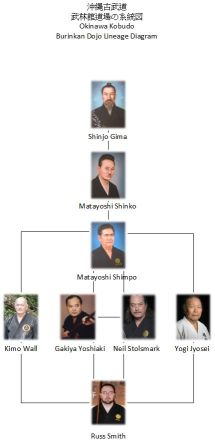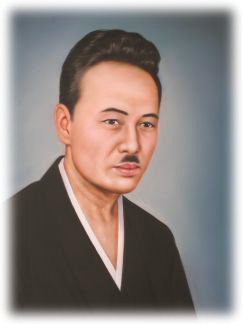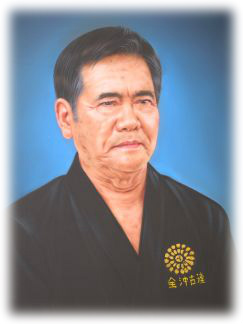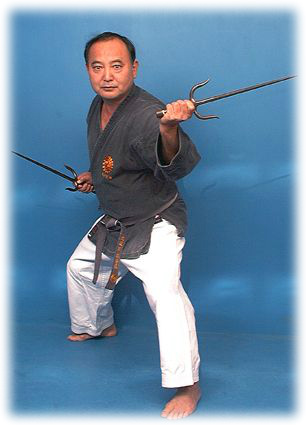Okinawan Kobudo
Lineage
Okinawan Kobudo
Burinkan Dojo
Lineage Diagram

In the 1800’s, trade and cultural exchange between China and Okinawa flourished. As a part of this cultural exchange, the then current generation of the Matayoshi family, Matayoshi Shinchin and Shintoku, began to study Southern Shaolin Kempo, and from this the roots of Ryukyu Kobujutsu in the Matayoshi family began.
Matayoshi Shinko (又吉眞光)

The third son of Matayoshi Shinchin was born in Meiji 21 (1888) in the Kakehana area of Naha city, Okinawa and grew up in the Shinbaru area of Chatan village. From a very young age he studied under the bushi Agena Chokubo (also known as Gushikawa Teragua), of Gushikawa village. Under his instruction he mastered the bo, eku, sai, and kama. He also studied tonfa and nunchiyaku from master Irei, of the Yari area of Chatan village. Later, towards the end of the Meiji period, he traveled through Hokkaido and into Sakhalin island, Manchuria, Shanghai, Fuchow, and Vietnam in pursuit of martial knowledge and training. While staying in Manchuria he lived with a group of mounted bandits, and from them learned shuriken throwing and lasso techniques. In Manchuria he also studied Shaolin Boxing. In Shanghai he met Kingai roshi, and from him learned the nunti, tinbe, traditional Chinese medicine, acupuncture, and moxibustion, among other things. He returned to Okinawa for good in Showa 10 (1935). Matayoshi Shinko was also known as “Kama nu ti Mateshi” (Matayoshi of the Kama), and “Shinbaru Mateshi”. He passed away in Showa 22 (1947) at the age of 59.
Matayoshi Shimpo (又吉眞豊)

Matayoshi Shinpo was born in December of Taisho 10 (1921), in the village of Yomitan, in Okinawa prefecture. Starting in Showa 2 (1927), when he was six years old, he began intense training in Ryukyu Tode and Kobujutsu under his father. Over time, he became more and more involved Okinawa’s karate community, taking instruction from many famous teachers, including Gokenki (吳賢貴), from whom he learned White Crane Boxing.
After the war, he had to stay where he was living in Kawasaki city, in Kanegawa prefecture, and while there diligently taught and studied his art. In Showa 35 (1960), he was able to return to Okinawa and undertook the task of teaching kobudo in various places, especially Higa Seiko’s Goju Ryu dojo. He was keenly affected by the current situation in Okinawa, one in which karate was developing into a world-wide budo and yet kobudo was receiving little recognition, while its best teachers grew fewer and fewer. With this in mind, in 1976 he founded the Kodokan (光道館) dojo, taking as part of its name a character from his father’s name (Ko). He did this with the hope of developing kobudo within the prefecture, and then, from this foundation, widely introducing and popularizing Okinawan Kobudo throughout the country and overseas. He saw this happening hand in hand with increasing cultural exchange through budo, improving international friendship, and all the other great rewards that this could reap.
He was a founding member of the All Okinawa Kobudo Association (Zen Okinawa Kobudo Renmei), and its president for many years, the head Okinawa representative for the All Japan Martial Arts Organization (Dai Nippon Butokukai), and a member of the Japanese Kobudo Society; in these roles he deepened exchange between kobudo teachers all over the country, worked hard at increasing exposure to the kobudo arts, and continually worked to introduce people to the true meaning of traditional bujutsu, both within the country and overseas. His art gained the nickname “Matayoshi Ryu Kobudo”, and became widely known world-wide due to his efforts. He passed away in Heisei 9 (1997), at the age of 75, after a life dedicated to the research and development of Karate and Kobudo.
Gakiya Yoshiaki (我喜屋良章)

Gakiya Yoshiaki was born in Showa 25 (1950), in Yomitan village in Okinawa prefecture. In 1967 he began studying Goju Ryu karate under Fukichi Seiko (福地清幸), and in 1980 he began studying Shorin Ryu under Nakamura Yoshio (仲村良雄). In 1975 he joined the All Okinawa Kobudo Association, entering its main dojo, the Kodokan, and training under Matayoshi Shinpo sensei. He became Matayoshi sensei’s right hand man, and worked diligently as the main instructor at the dojo and traveling around Japan and overseas in an effort to teach and popularize the art. In 1997, after Matayoshi sensei passed away, he was appointed the second Kancho (president) of the Kodokan dojo, and as successor continued to work for its expansion and development.
In January of Heisei 14 (2002), he founded the Okinawa Kobudo Doshi Renseikai (沖縄古武道同志練成会). He built the Renseikan (錬志館) dojo as a place where kindred spirits in the study of Okinawa Kobudo could come to train hard and polish their character.
(Above text provided by Gakiya Yoshiaki, translated by Sensei Fred Lohse)

